20+ SAMPLE Termination Notice
-

Notice of Termination from Tenant to Lessor
download now -
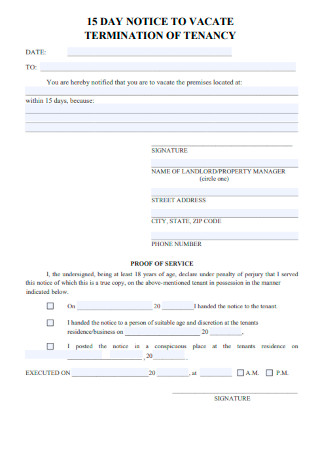
15 Day Notice to Vacate Termination of Tenancy
download now -
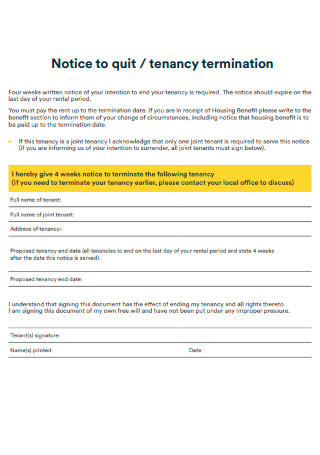
Notice to Quit Tenancy Termination
download now -
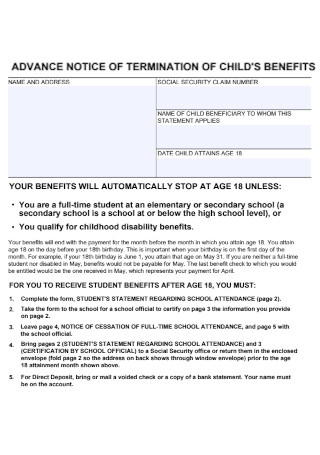
Advance Notice of Termination of Childs Benefits
download now -

30 Day Notice of Termination of Lease
download now -
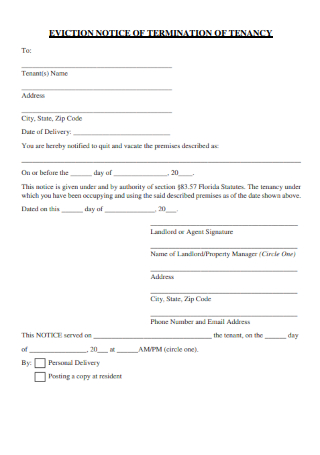
Eviction Notice of Termination of Tenancy
download now -
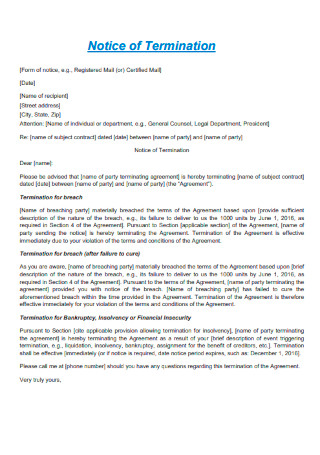
Basic Notice of Termination
download now -
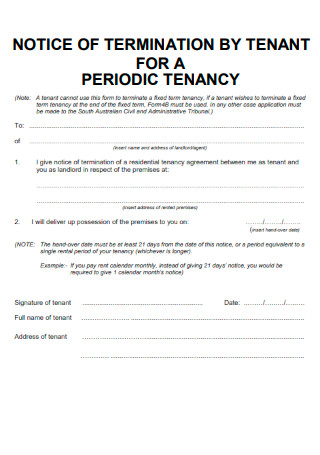
Notice of Termination by Tenant for a Periodic Tenancy
download now -
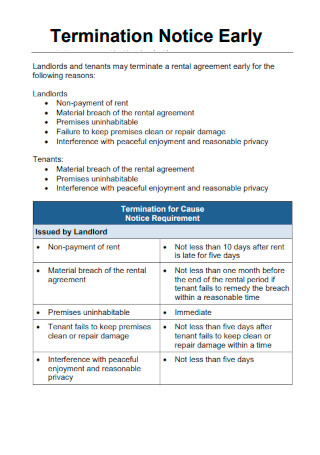
Termination Notice Early
download now -
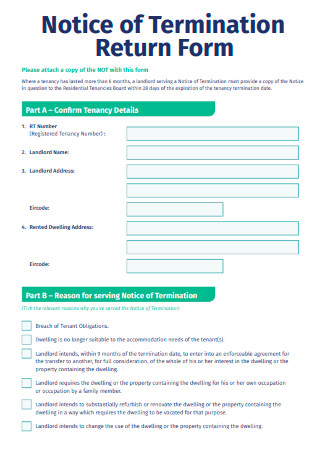
Notice of Termination Return Form
download now -
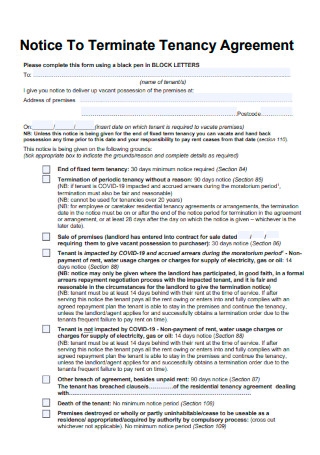
Notice To Terminate Tenancy Agreement
download now -
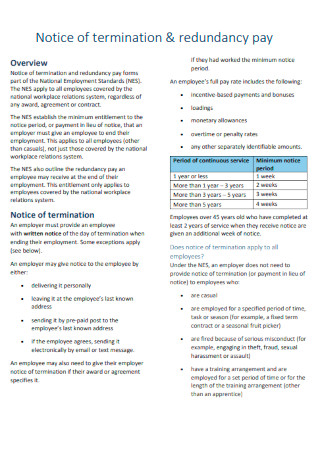
Notice of Termination & Redundancy Pay
download now -
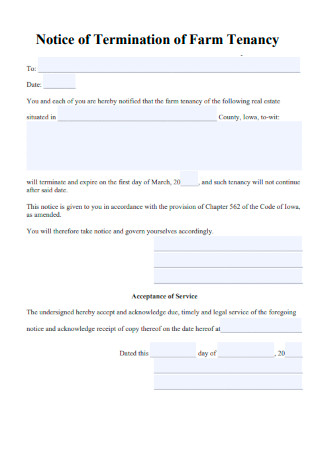
Notice of Termination of Farm Tenancy
download now -

Notice of Termination of Commencement
download now -
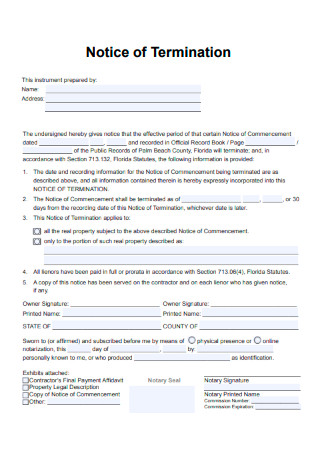
Sample Notice of Termination
download now -
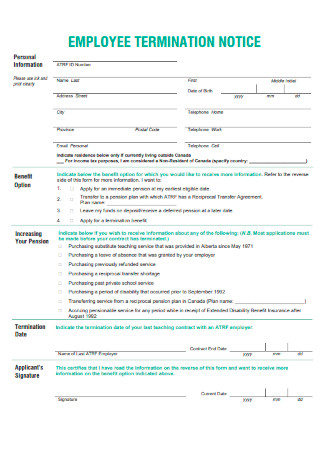
Employee Termination Notice
download now -
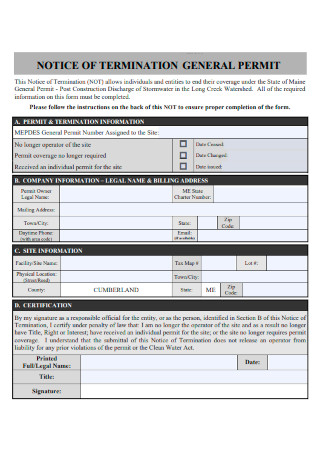
Notice of Termination General Permit
download now -
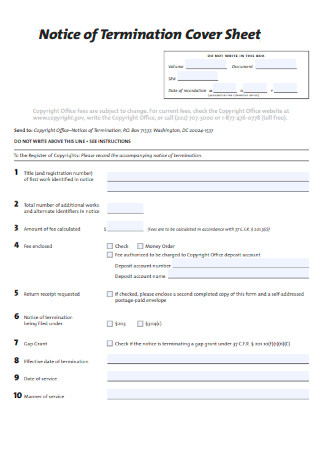
Notice of Termination Cover Sheet
download now -
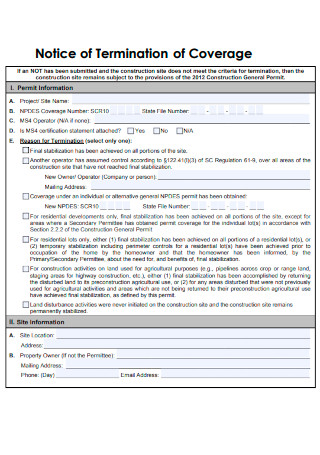
Notice of Termination of Coverage
download now -
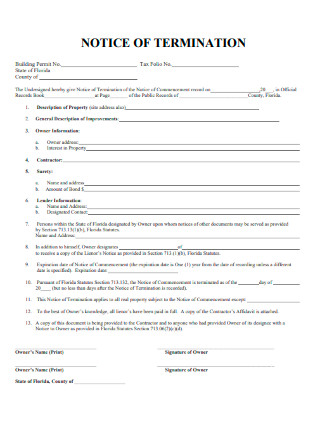
Printable Termination Notice
download now -
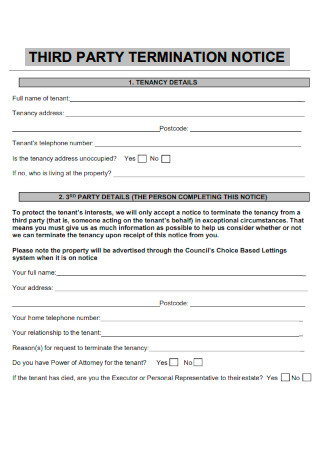
Third Party Termination Notice
download now
FREE Termination Notice s to Download
20+ SAMPLE Termination Notice
What Is a Termination Notice?
Types of Termination Notices for Tenants
How To Terminate the Lease of a Tenant
FAQs
How do you end a lease agreement?
On what grounds can a landlord terminate a lease?
How do you give a 30-day notice to a tenant?
What Is a Termination Notice?
Termination notice for a lease is a legal document to convey to a tenant that they are under the jurisdiction to vacate or move out of a rented or leased space or property before the original termination date of the lease agreement or contract ends. Landlords and property owners utilize the document to communicate the vital details regarding the date and the reason for termination. In many states and areas, landlords, property managers, or owners are under the legal obligation to provide written notice of termination to tenants. While the other party can provide verbal notice to the tenant, a legal document must be in a written notice for the delivery of the termination to be legally valid. In the case that a landlord does not provide a written notice to the tenant, they are permitting the individual or individuals to stay on the premises for a longer time in contrast to their termination date or that the landlord has the responsibility to shoulder financial problems and issues that the tenants experience due to the lack of notice to vacate.
According to the data table of the United States Census Bureau for the Household Pulse Survey Week 43, covering March 2 to 14, 2022, out of 8.26 million property tenants, over 1.02 million of them are very likely of leaving their homes due to eviction in the next two months.
Types of Termination Notices for Tenants
It is the responsibility of a landlord to have the knowledge and understanding of local laws, policies, and procedures regarding leases and lease termination. While most information is accurate for general notices, it is the responsibility of a landlord to double-check the rules and regulations for implementing notice periods to tenants. Make sure to indicate the names, addresses, and contact information of the tenant and landlord, the date of the notice, the notice period, the process to stay on the property, and details about the receipt of the notice. Anytime a landlord sends out a notice of termination, three different situations are applicable. The section below tackles the different types of termination notices available.
How To Terminate the Lease of a Tenant
The process for terminating the lease of a tenant begins when a tenant shows little to no response to act on an issue that the landlord or property manager wants to address or they refuse to settle rental fees for a rented property. As mentioned in the section above, there are different types of termination notices that lead to the eviction process of a tenant. If and when the termination notice results in an eviction of the tenant, the section below details and discusses the process of terminating the lease of a tenant.
-
1. Review the Lease Agreement
The first step in the termination process for the lease is to review the lease agreement between the parties. Every lease agreement contains guidelines, policies, and provisions that relate to the eviction process of a tenant. In many month-to-month leases, the lease agreement contains the minimum period for a landlord to terminate the lease. Standard leases are the most common type of lease agreement with the landlord implementing the agreement for a fixed period. A landlord can send a lease termination notice 30, 60, or 90 days in advance. In very rare instances that the agreement does not specify or mention a specific timeline or timeframe for the implementation of termination, follow the state-required notice period for the procedure.
-
2. Make Sure To Have Clear Communication Channels with the Tenant
Before sending a termination notice to a tenant, make sure that the landlord exhausts all possible means to communicate the intent to terminate the lease agreement. It is significant for the landlord or a property manager to establish a form of communication with the tenant they intend to evict from the property. It is during this step that the tenant can offer to make amends to the landlord, whether by paying the full amount for late rent payments or for repairing or fixing issues relating to the rented property. It can also be a way to end the relationship on good terms. For example, if the landlord decides to terminate the lease, it helps both parties to start organizing and arranging moving out schedules for the tenant.
-
3. Send the Notice to the Tenant
If the tenant and landlord do not settle on terms of payment or fix the issues relating to the rented property, the landlord sends the termination notice to the tenant. There are various ways to send the notice to the tenant. However, every state has different rules for delivering notices, so a landlord must check the eviction laws for a particular state. Some states require landlords to send the notices to tenants personally. Others recommend landlords send the notice through certified mail as it is the best option because the courier provides a return receipt to the landlord after a successful delivery. Another option is to send it with a certificate of service for personal deliveries or any other type of delivery to serve as proof of delivery.
-
4. Schedule the Date for Moving Out
After sending the termination notice and after the receipt of the tenant, the landlord must schedule the move-out date for the tenant. For larger residential complexes, the landlord must make the necessary arrangements with management regarding the movement of appliances, fixtures, and furniture that require utilizing elevator services and other means of transport.
-
5. File for the Eviction in Court as Necessary
If a tenant refuses to receive the notice or receives the notice but refuses to settle or leave the rented property, the landlord has the right to seek legal advice from a practicing attorney which leads to an eviction lawsuit in a local court of law. Even if the tenant mentions that they will not vacate the premises no matter what, the landlord must wait for the full notice period to expire before filing for an eviction lawsuit.
FAQs
How do you end a lease agreement?
For a landlord to end a lease agreement, they must send a notice to a tenant that terminates their tenancy for a rental unit. The lease termination letter that the landlord sends must include information about the when and why it is necessary for the agreement to come to an end.
On what grounds can a landlord terminate a lease?
Landlords can only terminate a lease for valid and legal reasons. Some examples include non-payment of rent, breaking the terms of the lease, illegal activities in the rental, or the non-renewal of the lease agreement.
How do you give a 30-day notice to a tenant?
The best and most practical way to provide a 30-day notice to a tenant is to give them a written notice letter. Make sure that the letter details the date and reason for vacating the rental and the contact information of the landlord if there are questions or inquiries about the notice.
Establishing positive relationships with tenants must be the priority of landlords. However, if tenants continue to refuse to pay their rental fees, break the terms of the contract, and perform illegal activities on the property, the landlord has no other choice but to serve a termination notice. When serving the termination notice to tenants, make sure there is proper communication between the two parties to arrive at a possible agreement. Write a termination notice for a rental property by downloading the 20+ Sample Termination Notice in PDF at Sample.net.
